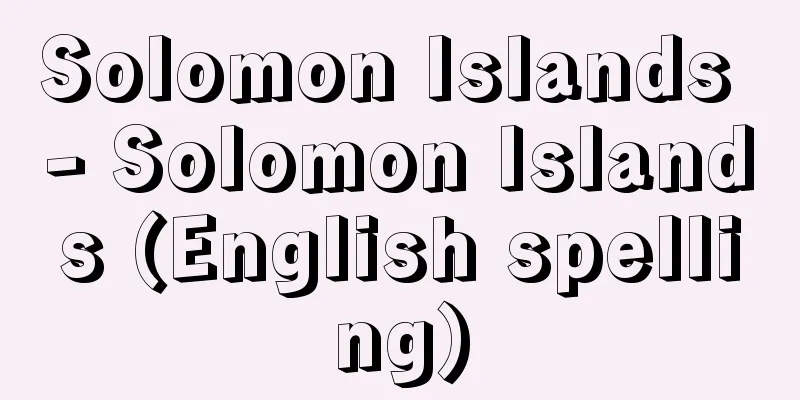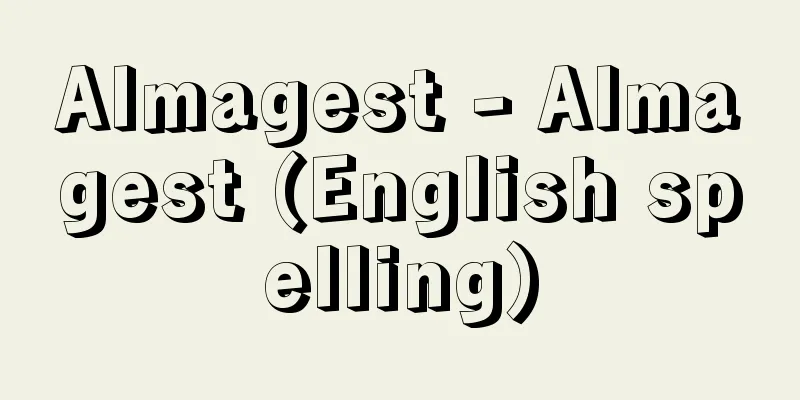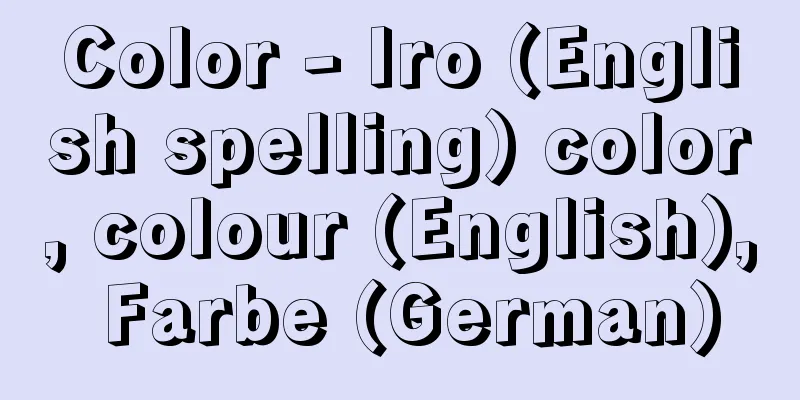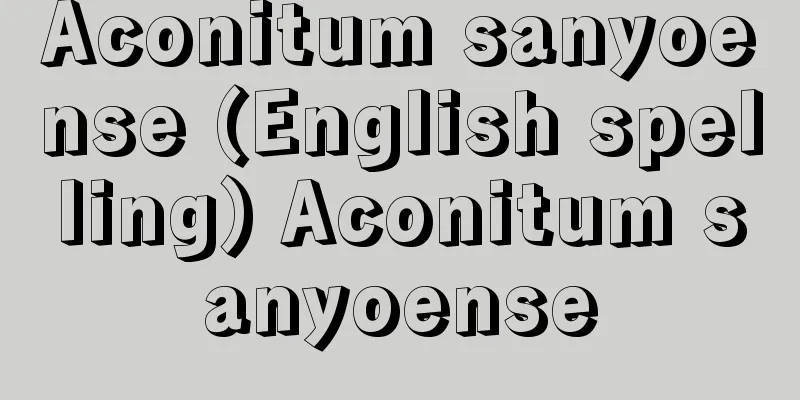Solomon Islands - Solomon Islands (English spelling)

|
A Melanesian archipelago nation located 1,800 km northeast of Australia. With a land area of 28,896 square kilometers, it is the second largest Pacific island nation after Papua New Guinea. Its population is 483,000 (2006 estimate), 523,170 (2009, World Bank). It gained independence from the UK in July 1978. The currency used is the Solomon dollar, and English is the official language. As there are many different tribes that speak different languages, pidgin English is used as a common language among the people. The capital is Honiara on Guadalcanal Island, and its population is about 60,000 (2010). [Izumi Kobayashi] Nature and GeographyThe country, which is made up of 1,000 islands of various sizes, is divided into nine provinces. There are six main islands, Choiseul Island, Santa Isabel Island, and Malaita Island in the north, and New Georgia Island, Guadalcanal Island, and San Cristobal Island in two rows in the south. Many of the islands are hilly and covered with tropical rainforest, but the largest island, Guadalcanal, has a mountain that is over 2,000 meters above sea level. Since it was connected to Papua New Guinea in the past, there is a mixture of old geology of land islands (islands with continental shelves) and volcanic islands, and it is also known as an island where earthquakes occur. The climate is hot and humid throughout the year, but there is a relatively little rainfall from May to December. Although the country's territory is scattered throughout the ocean, due to the neighboring islands of Papua New Guinea and Vanuatu, the exclusive economic zone is only 1.34 million square kilometers, smaller than that of the Cook Islands. 95% of the population is of Melanesian descent, and just under 20% of the total population is employed in wage labor in urban areas, while the majority of the population makes a living through traditional subsistence agriculture, which involves cultivating roots and stems such as taro, yams, and cassava, as well as beans, using slash-and-burn methods, and through coastal fishing. [Izumi Kobayashi] historySpanish explorer Alvaro de Mendanía, who set sail from Peru in South America, named the island he reached in 1568 Santa Isabel. When he returned to Peru, he named the area, including the surrounding islands, the Solomon Islands. This was named after the legend of King Solomon's lost gold, which appears in the Old Testament, and was intended to attract interest from Spain and raise funds for another expedition. However, it was 27 years before the second expedition was realized, and Mendanía died of malaria without finding any gold. For about 300 years after that, the islands were almost forgotten, and interest in them increased again only in the 19th century. Whaling ships called at the port, traders looking for sea cucumbers, sandalwood, and tortoiseshell, and missionaries from various Christian denominations came and went, and white people called beachcombers also settled there. In 1893, Britain declared ownership of the central and eastern islands, and in 1900, on the condition that it withdraw from Samoa, over which it was in dispute with Germany, it acquired the northwestern part, which was German territory, and made the entire present-day Solomon Islands a colony. In 1942, the year after the Pacific War began, Japanese forces advanced onto Guadalcanal Island, and the island and the surrounding waters became the main battlefield between Japan and the United States, with over 20,000 Japanese soldiers killed in action. After the Pacific War ended, the Solomon Islands were ruled by the United Kingdom again. As the momentum for colonial independence grew in various areas, the United Kingdom considered withdrawing from the Solomon Islands, and in 1970, it established an autonomous council with elected representatives. An autonomous government was established in 1976, and the Solomon Islands gained independence in 1978. [Izumi Kobayashi] PoliticsThe government is a constitutional monarchy with the Queen of England as head of state, and the Governor-General, who represents the Queen, is elected. The Parliament is unicameral with 50 seats and serves a four-year term. The government is a parliamentary cabinet system, with the Prime Minister and 20 Cabinet members. The geographical boundaries of the country were decided for the convenience of British colonial rule, and there was no need for the inhabitants of each island, with their different languages and customs, to be unified under a single administration. The people of the Solomon Islands did not have a sense of nationhood that viewed the Solomon Islands as a community with a common destiny, and as a result, the interests of the islands of origin and the conflicts between tribes were always reflected in politics. This drawback became evident in the violent tribal clashes that occurred in 1998. Many civil servants and workers from Malaita, located across the shore, live on Guadalcanal Island, where the capital is located. Malaita people intensified their retaliation against the Guadalcanal people who tried to exclude them. This escalated to the point where the prime minister was arrested by Malaita armed forces in June 2000. A change of government occurred and a peace agreement was signed between the government and representatives of the armed forces of Guadalcanal and Malaita, but the turmoil did not subside even after that. In the end, security finally improved with the dispatch of the Regional Assistance Mission to Solomon Islands (RAMSI) in 2003, which was mainly composed of police and military forces from Australia and New Zealand. In August 2010, a general election was held peacefully under the supervision of an international election observer group, and a new government was inaugurated, but this does not fundamentally resolve the issue. The debate over whether to maintain a centralized system or to create a federal state with decentralized powers will likely continue into the future. [Izumi Kobayashi] Economy and Society75% of the population is engaged in self-sufficiency agriculture and coastal fishing. The surrounding seas are good fishing grounds, and the fishing industry was established early on through joint ventures with foreign companies. Primary products such as fish and shellfish, copra (dried endosperm of coconut fruit), and palm oil are the few export items, and the annual value of these exports is about 40 million US dollars. In the 1990s, timber logging operations, mainly funded by Malaysian capital, became popular, and the country now earns more than 60 million US dollars a year from these exports, but environmental destruction caused by deforestation has also become a problem. Mineral resources such as bauxite, gold, copper, manganese, and nickel have been confirmed to exist, but development has not progressed. Due to the relatively large islands scattered across the country, the development of traditional village communities, except for urban areas, has hardly progressed, and the monetary economy has not been fully established. This is because colonial administration did not reach the rural areas, which is the reason why the adult literacy rate remains low at around 60%. The typical economic structure of Polynesia and Micronesia was that the shortage of domestic production was compensated for by remittances sent by people working overseas. However, Melanesian countries such as the Solomon Islands had little contact with Westerners, and were not influenced by colonialism, so they were slow to adapt to modern society, and the conditions for going abroad to work were not in place. This is why the GNI (gross national income) per capita of this country, which has a large land area and abundant potential mineral resources, is the lowest in the region at $910 (US dollars, 2009). The GDP (gross domestic product) of the entire country is $480 million (US dollars, 2009). However, it can be said that the lives of people in this traditional society, which has a primitive wealth, are much richer than one would imagine based on this level of cash. Christianity spread from the time of the sudden influx of Westerners in the 19th century, and now almost the entire population has become Christian due to the activities of various Protestant denominations. In 1998, East Rennell Island, the southernmost island, was registered as a World Heritage Site (natural heritage) (in 2013, it was added to the List of World Heritage in Danger). The education system consists of a 6-year primary education and a 7-year secondary education, and the language of instruction is English. Because there are many remote islands and underdeveloped areas, the primary education attendance rate is only about 60%. As for higher education institutions, there is a branch of the University of the South Pacific (main campus is in Fiji) and a teacher training college in the country, but those who receive scholarships can go abroad to universities in Australia or the main campus of the University of the South Pacific. [Izumi Kobayashi] Relations with JapanGuadalcanal Island and its surrounding islands, the site of fierce battles between the Japanese and American armies during the Pacific War, are still visited by memorial groups from Japan. The runway at Honiara International Airport was built on the site of a former Japanese military construction. The construction of the airport building was also assisted by Japan. Despite the history of war, the general population has no anti-Japanese sentiment and is pro-Japanese. Japan has signed a fishing agreement with the island, and Japanese fishing boats operate in the nearby waters. The cumulative amount of ODA (Official Development Assistance) provided by Japan as of 2009 (Heisei 21) was 28.341 billion yen, and there are about 70 Japanese people residing in the island, mainly aid workers such as the Japan Overseas Cooperation Volunteers (JOCV). There is also a resident office in Honiara, which is also under the jurisdiction of the Japanese Embassy in Papua New Guinea. [Izumi Kobayashi] "Life History of the Solomon Islands" edited by Tomoya Akimichi, Hisao Sekine, and Ryuichi Tai (1996, Akashi Shoten) " "The Last Tropical Rainforests of the Solomon Islands" edited by Ryutaro Otsuka (2004, University of Tokyo Press) [References] | | | | | [Supplementary information] |"> Solomon Islands flag ©Shogakukan Illustration/Shogakukan Creative "> Solomon Islands Location Map Source: Shogakukan Encyclopedia Nipponica About Encyclopedia Nipponica Information | Legend |
|
オーストラリアの北東1800キロメートルに位置するメラネシアの群島国家。国土面積2万8896平方キロメートルで、太平洋島嶼(とうしょ)国のなかではパプア・ニューギニアに次ぐ広さである。人口48万3000(2006年推計)、52万3170(2009年、世界銀行)。1978年7月にイギリスから独立。使用通貨はソロモン・ドルで、英語が公用語。部族ごとにたくさんの言語があるので、人々の共通語としてピジン英語が使われている。首都はガダルカナル島のホニアラで、人口は約6万(2010年)。 [小林 泉] 自然・地誌大小1000もの島々からなる国土は、九つの州に区分されている。主要島は六つあり、北側にチョイスル島、サンタ・イザベル島、マライタ島、南側にニュー・ジョージア島、ガダルカナル島、サン・クリストバル島が2列に並んでいる。熱帯雨林に覆われた丘陵島が多いが、国内最大のガダルカナル島には標高2000メートルを超える山がある。古くはパプア・ニューギニアと陸続きだったため、古い地質の陸島(大陸棚が存在する島)と火山島が混在しており、地震のある島としても知られる。気候は1年を通じて高温多湿であるが、5月から12月にかけては比較的雨の少ない季節である。国土が海洋に分散しているが、パプア・ニューギニアやバヌアツの島が隣接しているために、排他的経済水域はクック諸島よりも狭い134万平方キロメートルにとどまっている。 住民は95%がメラネシア系で、総人口の2割弱が都市部で賃金労働に従事しているが、そのほかの大半の国民はタロ、ヤム、キャッサバなどの根茎類や豆類を焼畑で耕作する伝統的自給農業や沿岸漁業で暮らしを立てている。 [小林 泉] 歴史南アメリカのペルーから出航したスペインの探検家アルバロ・デ・メンダーニアは、1568年に到達した島をサンタ・イザベルと名づけた。ペルーに戻った彼は、周辺島嶼を含めてこの一帯をソロモン諸島と命名する。これは旧約聖書に登場するソロモン王の失われた黄金伝説にちなんだもので、本国スペインの関心を集めて再度の探検資金を調達するためであった。しかし、二度目の探検が実現できたのはそれから27年後、結局メンダーニアは黄金をみつけられずマラリアで死亡した。その後の約300年間はほとんど忘れ去られた諸島となり、ふたたび関心が高まるのは19世紀に入ってからであった。捕鯨船の寄港、ナマコや白檀(びゃくだん)、べっこうなどを求める貿易商、キリスト教各会派の宣教師が行き交い、ビーチコーマーとよばれる白人たちも住み着くようになった。イギリスは1893年に中部・東部の島々の領有を宣言、さらに1900年にはドイツと領有権を争っていたサモアからの撤退を条件に、ドイツ領であった北西部を獲得して、現在のソロモン諸島全域を植民地とした。 太平洋戦争が始まった翌年の1942年、日本軍がガダルカナル島に進出すると、同島および周辺海域は日米の主戦場と化し、日本人将兵2万人超の戦死者を出した。 太平洋戦争終戦後はふたたびイギリスの統治が始まった。その後の各地での植民地独立機運の高まりのなかでイギリスはソロモン諸島からの撤退を視野に入れ、1970年に公選議員による自治評議会を発足させた。1976年には自治政府が樹立され、1978年にソロモン諸島として独立した。 [小林 泉] 政治政体はイギリス女王(国王)を元首とする立憲君主制で、女王の名代を務める総督は選挙で選ばれる。議会は議席数50の一院制で任期は4年。議院内閣制をとっており、政府は首相と20人の閣僚で構成される。 この国の地理的範囲は、イギリスの植民地統治の都合により決められたもので、言語、慣習が異なるそれぞれの島の住民にとっては単一行政で統合される必然性は皆無であった。人々にはソロモン諸島を一つの運命共同体としてとらえる国家意識はなく、結果としてつねに出身島の利害や部族間の対立が政治に反映されることになった。この弊害が顕著に表面化したのが、1998年に起こった激しい部族衝突である。首都の置かれるガダルカナル島には、対岸にあるマライタ島出身の公務員や労働者が多数居住しているが、これを排斥しようとしたガダルカナル人に対するマライタ人の報復が激化したのである。これが2000年6月には、マライタ人武装勢力による首相拘束事件にまで発展。政権交代が起こり、政府とガダルカナル、マライタ双方の武装勢力代表の間で和平協定が結ばれたが、その後も混乱は収まらなかった。結局、2003年にオーストラリア、ニュージーランドの警察・軍が中心となったソロモン地域支援ミッション(RAMSI=Regional Assistance Mission to Solomon Islands)が派遣されて、ようやく治安が改善された。2010年8月、国際選挙監視団が監視するなか、総選挙が平和裏に実施されて新しい政権が発足したが、これで本質的な解決とはならない。中央集権制を維持するか、地方分権による連邦制国家にするかの議論は今後も続くであろう。 [小林 泉] 経済・社会国民の75%は自給的な農業や沿岸漁業に従事している。周辺海域は好漁場で、外国との合弁による水産業は早くから始まっている。魚貝類、コプラ(ココヤシの果実の胚乳を乾燥させたもの)、パーム油などの一次産品が数少ない輸出品目で、これらの輸出額は年間4000万ドル(アメリカ・ドル)程度。1990年代になって、主としてマレーシア資本の木材伐採事業が盛んになり、この輸出で年間6000万ドル(アメリカ・ドル)以上を稼ぎ出しているが、一方で森林伐採による環境破壊も問題になっている。ボーキサイト、金、銅、マンガン、ニッケルなどの鉱物資源の存在も確認されているが、開発は進んでいない。 比較的大きな島が分散しているため、都市部を除いた伝統的な村落社会の開発がほとんど進んでおらず、貨幣経済も十分に浸透していない。それは植民地行政が地方まで及ばなかったからで、成人の識字率を60%程度の低い水準にとどめている原因である。国内生産の不足は、海外出稼ぎによる送金で補っているのがポリネシア、ミクロネシア諸国の典型的な経済構造であったが、ソロモン諸島などメラネシア諸国では西洋人との接触が少なく、植民地の影響を受けなかった分だけ現代社会への適応が遅れ、外国に出稼ぎに出る条件が整わなかった。国土も大きく潜在鉱物資源も豊富なこの国の1人当りGNI(国民総所得)が 910ドル(アメリカ・ドル、2009年)と域内で最低の水準にあるのは、そのためである。国全体のGDP(国内総生産)は4億8000万ドル(アメリカ・ドル、2009年)。しかし、原初的豊かさを秘めた伝統社会での人々の暮らしは、この現金水準で想像するよりもはるかに豊かだといえるだろう。 19世紀に入って急増した西洋人の流入時からキリスト教が浸透し、いまではプロテスタント系の各会派の活動によってほぼ全国民がキリスト教徒になった。1998年に、最南端にあるイースト・レンネル島(東レンネル)が世界遺産(自然遺産)に登録されている(2013年、危機遺産リスト入り)。 教育制度は、6年制の初等教育と7年制の中等教育が設けられており、教育使用言語は英語。離島や未開発地域が多いため、初等教育の就学率は60%程度にとどまっている。高等教育機関としては、国内に南太平洋大学(本校はフィジー)の分校と教員養成短期大学があるが、奨学金を得られた者はオーストラリアの大学や南太平洋大学本校など海外に出る。 [小林 泉] 日本との関係太平洋戦争で日米軍隊の激戦地となったガダルカナル島やその周辺諸島には、いまでも日本からの慰霊団が訪れている。ホニアラ国際空港の滑走路は、旧日本軍が建設した跡を整備してつくった。また、空港ビルの建設には日本の援助が入っている。戦争という歴史があったものの、一般住民に反日感情はなく親日的である。日本は入漁協定を結んでおり、日本漁船がこの近辺海域で操業している。2009年(平成21)までの日本からの累積ODA(政府開発援助)供与額は283.41億円になっており、青年海外協力隊をはじめとする援助関係者を中心に70人ほどの在留邦人がいる(2009)。ホニアラにも駐在官事務所が置かれており、駐パプア・ニューギニア大使館が兼轄している。 [小林 泉] 『秋道智彌・関根久雄・田井竜一編『ソロモン諸島の生活誌』(1996・明石書店)』▽『大塚柳太郎編『ソロモン諸島 最後の熱帯雨林』(2004・東京大学出版会)』 [参照項目] | | | | | [補完資料] |"> ソロモン諸島の国旗 ©Shogakukan 作図/小学館クリエイティブ"> ソロモン諸島位置図 出典 小学館 日本大百科全書(ニッポニカ)日本大百科全書(ニッポニカ)について 情報 | 凡例 |
<<: Psalmi Salomonis; The Psalms of Solomon
>>: Solomon - Soromon (English spelling)
Recommend
Bundaberg - Bundaberg (English spelling)
A city located in the southeast of Queensland, Au...
Mesopotamian Art
Art from the Mesopotamian region (which spans mos...
Sun crack
...Examples of marks on the upper surface of a la...
Plectropomus truncatus
…There are many delicious species, and they can b...
Sea trout
… In foreign countries, Atlantic salmon ( Salmo s...
Ezo Banryudo Cave
...Rice farming is the mainstay of agriculture, b...
Alexandrovsky, VD - Aleksandrovsky
...In terms of practice, the goal of "integr...
Bruhns, N. (English spelling) BruhnsN
...In northern Germany, Arp Schnitger produced th...
Isooctane
An aliphatic saturated hydrocarbon (alkane). It i...
Biarritz (English spelling)
A town on the Bay of Biscay in the Pyrenees-Atlant...
Kaizuihikan - Kaizuihikan
…When he was governor of Yingtian, he was dismiss...
Uguisuzawa [town] - Uguisuzawa
An old town in Kurihara County in northern Miyagi ...
Butty system
…In modern capitalist management, capitalists dir...
Temple architecture
Temple architecture in Japan was introduced from C...
Record of the extermination of locusts
An agricultural book published by Okura Nagatsune ...









